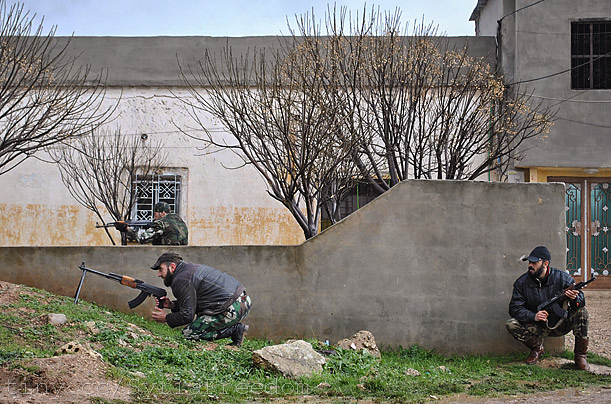Exaggeration serves no purpose when it comes to the Syrian crisis. From horrifying tales of rebel extremists eating hearts of dead men to acts of medieval corporal punishments, these past three years have made Syria a hub of the unimaginable. With this in mind, it should not be hard to believe that there are Los Angeles gang bangers currently fighting in Syria. This statement is true by virtue of information from a self-made, uploaded and viral online video (above) that has been circulating the Internet. To many, such a video is the epitome of real-life comedic gold. To this author, this is a direct representation of the vastly complicated situation in which Syria finds itself.
The video shows two distinct gang members. One who is self-proclaimed to be a “sureño,” — member of the Sur-13 gang, whereas the other is from the “Armenian power gang”: two of some of the most notorious gang organizations of Los Angeles. Both are there for one reason, to be “gangbanging in Syria, homie.” These two individuals fit the bill: full-body tattoos, specified gang slang, unique gang names, and unorthodox techniques when using semi-automatic rifles. The only difference is their location: they are no longer in the neighborhoods of Los Angeles; but rather, they have appeared in the war-torn streets of Syria.
Western intelligence agencies have known for a few years now that Syria has been a magnetic center that is particularly good at attracting a heterogeneous mix of foreign fighters. Unfortunately, after seeing a real video containing the same level of absurdity one would expect out of an SNL skit, it is clear that it is very difficult to classify the current situation in Syria. The bottom line is this: If American gang members have found themselves in the Syrian trenches, then who isn’t there?

Syria thus far has attracted quite the mix of foreign fighters, most to fight against the regime, but some to fight for Assad. There have been video reports of Bosnians, Chechens, and Australians going to fight with the Jihadist factions of the Syrian rebels. Of course, this is not the first time foreign Jihadi groups have found themselves traveling internationally, as similar practices were seen in the wars of the Caucasus, Afghanistan, and even Iraq. The difference, however, is the volume in which these foreigners are entering. Conservative estimates believe that there are around “7,500 foreign fighters from some 50 countries” currently there. And in sarcastic Levantian style, the joke du jour in Syria is that budding job markets have emerged for language translators!
Considering the bizarreness of the type of individuals seen in Syria and the sheer diversity in fractions informed by different goals and ideologies involved in the fight, the challenges that the rest of the world face seem inestimable. Many revolutions, wars, and conflicts of the past have had the general tendency of connecting a faction with a face. For example, when one thinks of the Cuban revolution, the immediate image of Fidel or Ché comes to mind. When the 2008 financial crisis is mentioned, the clips and videos of Occupy Wall Street represent a familiar icon. For Syria, however, this is not so clear-cut — on any side of the fighting. The LA gang members appear to be fighting for the Syrian regime — presumably to protect the ethnic minority Armenian Christians in Syria from terrorist extremism. But could they be the face of the regime? Are the foreign fighters the face of the Syrian opposition? Does it even make sense to imagine a non-Syrian fighter to be the face of any side of the crisis? The answer is a resounding “no” for such questions. Such a problem makes the Syrian crisis increasingly difficult to resolve on an international level. Regardless of the humanitarian issues that arise— and there have been an innumerable amount of those— it would only cause more harm to support any side of the conflict. Since we do not know which “side” we are supporting, and who will suffer the consequences, it would make the most sense to simply let the conflict pan out on its own.
Even though the gangsters are not actually significant to the trajectory of the crisis in Syria, they are largely symbolic of the world we live in. We currently live in an age where globalization has been a means — more often than not — of disturbing local social dynamics. On the global scale, we are physically and emotionally more interconnected with each other than at any previous point in human history. In prior ages, it would have been nearly impossible for a non-army affiliated individual from the Americas to be fighting a civil war in the Middle East. Even if it did occur, it was not until the 21st century that we are able to convey first-hand accounts of individuals with such massive circulation and legitimacy.
Such a form of globalization has many critics, and currently the most voiced concerns are those of the nearly nonexistent indigenous Free Syrian Army. Most Syrians — for or against the regime — only feel distrust and suspicion when it comes to the foreign fighters entering Syria. They have rightly felt that their revolution was hijacked by overzealous foreigners who do not follow local social conventions. Indigenous Syrians see that those who claim to help are only there to spread their own ideals throughout the region. This is the reason why the Syrian opposition has lost its appeal. It is fragmented, and the causes of their division has been paradoxically caused from without rather than from within. The call to jihad (via YouTube) by Al-Qaeda extremists has only created a misconstrued picture of the reality of the Syrian war, causing an influx of naive and ill-prepared young men to enter a deceptive cause.
This is certainly not the case for the sureños, but what is clear is that they were not spurred to fight by circumstances that took place in Los Angeles. Instead, their interest was piqued through a rather pervasive and equally pliable medium of information. It is unsettling to see that the same technology used to share humorous videos of kittens is also one that is used to attract fighters to Syria.
Regardless of how the two sureños are received by the Syrian army, they should only be viewed as a non-indigenous force who falsely believe that they are allowed a presence and purpose in Syria.
The involvement of any foreign interventionist is usually spurred by some incentive — whether it is moral or monetary. Regardless of such a persuasive force, foreign fighters need to see that when they enter a non-indigenous war, they are only increasing the chaos and harming the people they claim to help. Worse yet, foreign fighters — as evidenced by the sureños — bring about even more foreign fighters, many of whom tend to fight each other and only heighten the confusion surrounding the crisis.
In the end, considering the porous state of the Syrian borders, it is nearly impossible to stop anyone from “gangbanging in Syria.” Thus, the only preventative measure is persuasion, rather than forced travel inhibition. The world we live in is one where it is very difficult to avoid learning about events occurring across the globe. Varying radical ideologies that have a tendency to spread among impressionable individuals can only further color the nature of such events. Ultimately, we end up with videos like the one that inspired this article: the spread of ignorance and fatal flippancy across international lines.
